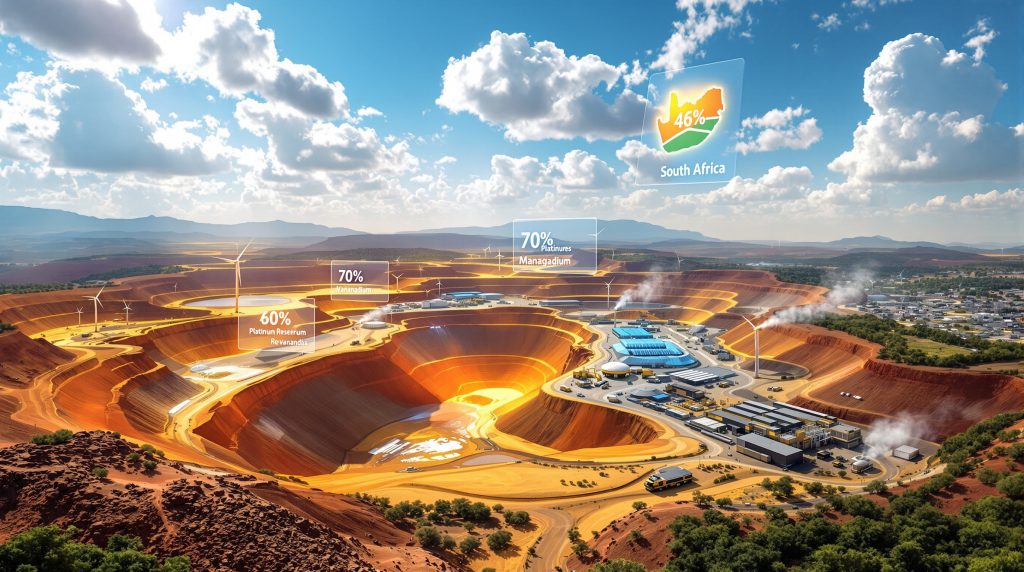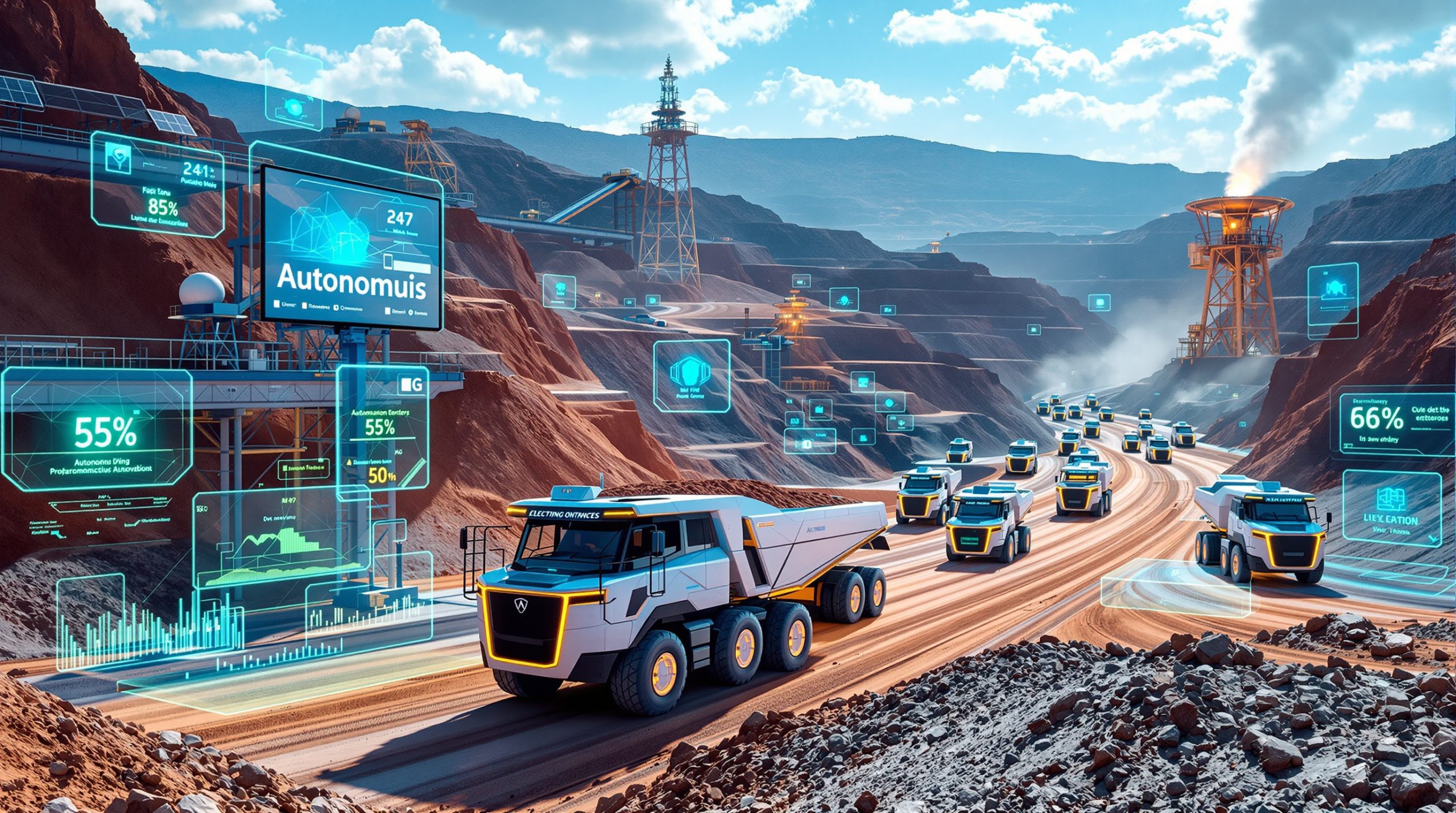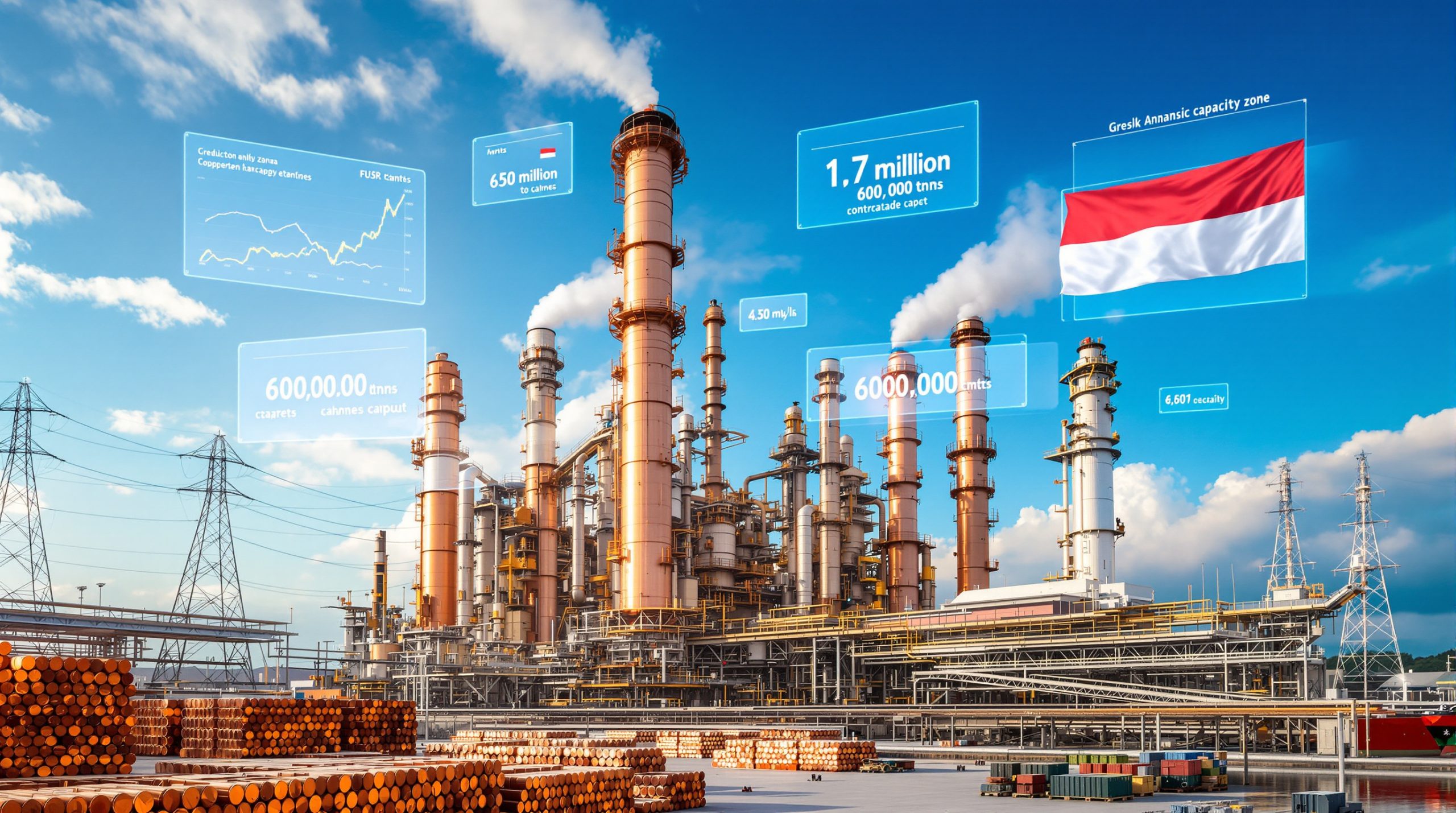Understanding South Africa's Strategic Position in Global Energy Transformation
South Africa stands at the intersection of traditional mining excellence and renewable energy innovation, positioning itself as a critical player in the future of energy and mining in South Africa and the worldwide transition to sustainable energy systems. The nation's geological endowments create unprecedented opportunities for leadership in the clean energy economy, particularly through its dominance in minerals essential for next-generation technologies.
Critical Mineral Resources Driving Clean Energy Technologies
The country's mineral wealth forms the foundation of modern renewable energy infrastructure. According to the U.S. Geological Survey's 2024 Mineral Commodity Summaries, South Africa controls approximately 95% of global platinum reserves and 90% of platinum group metal (PGM) reserves, far exceeding previously reported estimates. These metals serve as catalysts in hydrogen fuel cells, electrolyzers, and various clean energy applications.
Furthermore, critical minerals energy transition presents significant opportunities for South Africa's economic development. Manganese resources represent another strategic advantage, with South Africa holding roughly 75-80% of global reserves concentrated in the Kalahari Manganese Field.
This mineral plays a crucial role in battery cathode production, particularly for lithium-ion systems powering electric vehicles and grid-scale energy storage solutions. The nation's vanadium deposits account for approximately 35-40% of worldwide reserves, primarily located within the Bushveld Complex.
| Mineral | Global Reserve Share | Primary Applications | Strategic Importance |
|---|---|---|---|
| Platinum Group Metals | 95% | Fuel cells, hydrogen production | Essential for hydrogen economy development |
| Manganese | 75-80% | Battery cathodes, steel production | Critical for energy storage systems |
| Vanadium | 35-40% | Flow batteries, steel alloys | Key for grid-scale storage |
| Chromite | 70-72% | Stainless steel, superalloys | Infrastructure development support |
Renewable Energy Infrastructure Transformation
The Renewable Energy Independent Power Producer Procurement Programme (REIPPPP) has fundamentally altered South Africa's energy landscape since its launch in 2011. Through multiple bidding rounds, the programme has secured over R282 billion in investment commitments as of 2024, according to the Department of Mineral Resources and Energy.
Current renewable energy capacity continues expanding, with solar photovoltaic installations leading the charge across provinces with high solar irradiation levels. Wind energy projects concentrate along coastal regions, particularly in the Western and Eastern Cape provinces, where consistent wind resources support large-scale generation.
However, renewables and reform will define South Africa's mining future, creating additional opportunities for sector transformation. The integration challenges include grid stability concerns, transmission infrastructure limitations, and the need for flexible backup systems to manage intermittency.
Digital Innovation Reshaping Mining Operations
Technology adoption across South African mining operations accelerates as companies seek efficiency improvements, cost reductions, and enhanced safety performance. Data-driven mining operations are becoming increasingly important for the future of energy and mining in South Africa.
Digital transformation initiatives span from autonomous equipment deployment to artificial intelligence applications in geological analysis and resource optimization. Moreover, the mining industry evolution demonstrates how technology is reshaping traditional practices.
Automation Technologies and Implementation
Autonomous haulage systems represent the most visible automation trend, with Anglo American's Mogalakwena platinum mine serving as a pioneering implementation site. The company deployed autonomous trucks starting in 2019, demonstrating feasibility within South African operating conditions.
Advanced monitoring systems utilizing Internet of Things (IoT) sensors provide real-time data on equipment performance, environmental conditions, and worker safety parameters. These systems enable predictive maintenance strategies, reducing unplanned downtime while extending equipment lifecycles.
Key technological implementations include:
- Autonomous vehicle systems for ore transportation and material handling
- Predictive maintenance platforms using machine learning algorithms
- Digital twin technology for mine planning and operational simulation
- AI-powered geological modelling for resource estimation and extraction optimisation
- Remote operation centres enabling centralised monitoring across multiple sites
Data-Driven Operational Excellence
Modern mining operations generate massive datasets from sensors, equipment, and monitoring systems across their value chains. Processing and analysing this information enables optimisation opportunities previously unavailable to operators.
Real-time analytics support decision-making in areas including ore grade control, energy consumption management, water usage optimisation, and environmental compliance monitoring. Machine learning algorithms identify patterns and anomalies that human operators might overlook, improving both productivity and risk management.
Anglo American committed $1.5 billion over five years for technology and innovation investments, including digital transformation initiatives across its global operations, with significant focus on South African assets.
Community Engagement and Sustainable Development
Mining companies increasingly recognise that long-term operational success depends on maintaining positive relationships with local communities. Social licence to operate requires transparent communication, equitable benefit sharing, and meaningful participation in decision-making processes.
Equitable Benefit Sharing Mechanisms
Effective community engagement strategies encompass multiple dimensions of socioeconomic development. Companies implement comprehensive programmes addressing education, healthcare, infrastructure development, and local business support.
Successful community partnership approaches include:
- Local employment prioritisation through community hiring programmes
- Skills development initiatives building technical capabilities for sustainable employment
- Infrastructure investment in schools, clinics, roads, and utilities
- Supplier development programmes supporting local business growth
- Environmental stewardship initiatives protecting ecosystems and water resources
Addressing Historical Transformation Requirements
South Africa's Mining Charter 2018 mandates 26% minimum Black ownership in mining companies, along with requirements for skills development spending equivalent to 5% of annual payroll. These regulations address historical inequalities while building local capacity.
Social and Labour Plans (SLPs) require mining companies to submit five-year development commitments addressing human resource development, local economic development, community infrastructure, and mine closure planning. The Department of Mineral Resources and Energy monitors compliance through regular reporting and site assessments.
Collective community development spending by South African mining companies reached approximately R8.9 billion in 2023, according to Minerals Council data. This investment supports education, healthcare, infrastructure, and economic development initiatives across mining regions.
Transitioning to Low-Carbon Mining Operations
Mining companies face increasing pressure to reduce carbon footprints while maintaining operational efficiency and cost competitiveness. The transition involves integrating renewable energy systems, implementing energy efficiency measures, and adopting cleaner extraction technologies.
Renewable Energy Integration in Mining
Sibanye-Stillwater completed a 50 MW solar installation at its Kroondal operations in 2024, representing one of several renewable energy projects across the company's portfolio. The project demonstrates the technical and economic feasibility of large-scale solar deployment at mining operations.
Consequently, renewable energy mining transformation is accelerating across the sector. Sibanye also brought a 150MW Springbok solar plant online in the Free State, marking a significant milestone in mining sector renewable energy adoption.
| Technology | Typical Capacity Range | Primary Benefits | Implementation Considerations |
|---|---|---|---|
| Solar PV Systems | 50-200 MW | Reduced electricity costs, emissions | Land availability, grid connection |
| Wind Power | 100-300 MW | Grid independence potential | Wind resource assessment, permits |
| Battery Storage | 25-100 MWh | Load balancing, reliability | Capital costs, technology selection |
| Hybrid Systems | Variable | Optimal reliability and cost | System integration complexity |
Carbon Reduction Strategies
Anglo American committed to achieving net-zero Scope 1 and 2 emissions by 2040, with an interim target of 30% reduction by 2030 from 2016 baseline levels. This commitment encompasses energy efficiency improvements, renewable energy adoption, and process optimisation across operations.
Mining operations implement comprehensive decarbonisation programmes through multiple pathways:
- Energy efficiency upgrades in processing facilities and equipment
- Electric vehicle deployment for underground transportation systems
- Waste heat recovery for power generation and facility heating
- Process optimisation reducing energy intensity per unit of production
Overcoming Barriers to Sustainable Transformation
Despite significant opportunities, structural challenges impede the pace of sustainable development across South Africa's energy and mining sectors. Understanding these constraints enables targeted solutions and policy interventions.
Infrastructure and Logistics Constraints
Rail transportation challenges significantly impact mining operations' efficiency and cost structures. Transnet's freight rail performance declined by approximately 25% between 2018 and 2023, with iron ore and coal export lines operating below designed capacity.
The Richards Bay Coal Terminal, designed for 91 million tonnes annual capacity, exported only approximately 60 million tonnes in 2023 due to rail delivery constraints. Similar bottlenecks affect other mineral exports through Saldanha Bay and Durban ports.
Critical infrastructure bottlenecks include:
- Rail network limitations affecting mineral transport efficiency and costs
- Port capacity constraints creating export delays and storage challenges
- Electricity supply instability with over 200 days of load shedding in 2023
- Water supply challenges in mining regions facing increasing scarcity
Regulatory and Policy Uncertainties
Complex regulatory frameworks create investment hesitation through lengthy approval processes and compliance uncertainties. Environmental Impact Assessment procedures average 2-4 years for completion, according to Minerals Council data.
Multiple government departments oversee different aspects of mining operations, including the Department of Mineral Resources and Energy, Department of Forestry, Fisheries and Environment, and Department of Water and Sanitation. Coordination between agencies sometimes creates delays and conflicting requirements.
Load shedding costs the mining industry an estimated R3.75 billion monthly during Stage 6 implementations, highlighting the critical need for reliable power supply solutions and energy independence strategies.
Small and Medium Enterprise Innovation Drivers
Small, medium, and micro enterprises (SMMEs) represent crucial innovation catalysts within the energy and mining ecosystem. However, these businesses face significant barriers requiring targeted support mechanisms and enabling environments.
SMME Development Challenges and Solutions
The Mining Charter 2018 requires 70% of mining goods procurement and 80% of services procurement from South African companies, with specific Black Economic Empowerment targets. Current SMME participation levels suggest significant growth potential exists.
| Challenge | Impact on SMMEs | Potential Solutions |
|---|---|---|
| Limited capital access | Restricts technology adoption and growth | Blended financing, government guarantees |
| Market entry barriers | Prevents competition with established suppliers | Procurement set-asides, mentorship programmes |
| Technology gaps | Reduces competitiveness and efficiency | Technology transfer, university partnerships |
| Skills shortages | Limits operational capacity and quality | Training programmes, apprenticeship initiatives |
Innovation Ecosystem Development
Anglo American Zimele, established in 1989, has supported over 850 SMMEs through funding and mentorship programmes, creating over 30,000 jobs according to company reports. This demonstrates the potential impact of well-structured supplier development initiatives.
Exxaro's Enterprise and Supplier Development programme invested over R1.3 billion between 2018-2023 in supporting local businesses, focusing on mining-related services and equipment supply. Additionally, mineral beneficiation in South Africa creates opportunities for SMME participation.
Supporting SMME growth requires coordinated interventions:
- Incubation programmes for technology-focused startups
- Public-private partnerships facilitating market access opportunities
- Research and development grants for innovative mining solutions
- Regulatory sandboxes enabling technology testing and validation
Small Enterprise Finance Agency data indicates an R86 billion annual financing gap for SMMEs across all sectors, highlighting the scale of capital access challenges requiring innovative financial solutions.
Future Prospects for South Africa's Energy-Mining Integration
The convergence of energy and mining sectors creates opportunities for economic transformation, environmental sustainability, and technological leadership on both continental and global scales. Success requires coordinated action across government, industry, and community stakeholders.
Integration and Synergy Opportunities
Hydrogen economy development represents a significant opportunity leveraging South Africa's PGM resources alongside renewable energy capacity. The Hydrogen Society Roadmap (2022) projects potential to produce 10 million tonnes of green hydrogen annually by 2050.
Synergistic developments emerging include:
- Mining-powered renewable projects utilising mineral resources for clean energy infrastructure
- Circular economy models recycling mining waste for energy storage applications
- Hydrogen production facilities combining platinum catalysts with renewable electricity
- Battery material processing incorporating local manganese and vanadium resources
Investment Requirements and Market Opportunities
Bushveld Minerals advances vanadium electrolyte production capabilities for utility-scale battery applications, while various companies explore lithium-ion battery precursor material development using domestic manganese resources. Furthermore, green energy future for South African mining companies presents substantial investment opportunities.
Mintek, South Africa's mineral research organisation, continues developing fuel cell catalyst technologies meeting global standards, positioning the country as a potential leader in hydrogen economy supply chains. In addition, the future of energy and mining in South Africa depends on coordinated investment strategies addressing both sectors' transformation needs.
Investment Outlook: Achieving sustainable transformation across both sectors requires substantial capital deployment, with estimates suggesting hundreds of billions of rand in combined investments needed through 2030 to meet sustainability targets while maintaining economic competitiveness.
Disclaimer: Investment projections and market forecasts involve inherent uncertainties and should not be considered guaranteed outcomes. Readers should conduct independent research and consult financial advisors before making investment decisions.
Frequently Asked Questions About South Africa's Energy-Mining Transformation
What gives South Africa a competitive advantage in the global energy transition?
South Africa's exceptional mineral reserves, particularly 95% of global platinum reserves and substantial manganese and vanadium deposits, combined with world-class solar and wind resources, create a unique strategic position in clean energy supply chains. This geological advantage, coupled with established mining expertise and infrastructure, enables the country to play a central role in manufacturing technologies essential for renewable energy systems.
How quickly can mining operations integrate renewable energy systems?
Implementation timelines vary significantly based on project scale, grid connectivity, and regulatory approval processes. Solar installations typically require 18-24 months from planning to commissioning, while wind projects may need 24-36 months. Hybrid systems combining multiple technologies can optimise reliability but require additional planning time for system integration.
What role does government policy play in sector transformation?
Government policy frameworks provide essential regulatory certainty, infrastructure investment coordination, and incentive structures encouraging private sector participation. The REIPPPP demonstrates effective policy design, attracting over R282 billion in renewable energy investments. However, regulatory complexity and approval delays remain significant barriers requiring continued reform efforts.
How do communities benefit from mining operations?
Mining companies collectively spent approximately R8.9 billion on community development in 2023, supporting education, healthcare, infrastructure, and local business development. The Mining Charter mandates specific transformation targets, while Social and Labour Plans require companies to address community needs through five-year development commitments.
What are the main obstacles to faster transformation?
Infrastructure constraints, particularly rail and port capacity limitations, significantly impact operational efficiency. Electricity supply instability, with over 200 days of load shedding in 2023, forces companies to invest in energy independence solutions. Regulatory complexity and lengthy approval processes also delay project implementation and increase costs.
Further Resources:
Readers seeking additional information about South Africa's energy and mining transformation can explore reports from the Department of Mineral Resources and Energy, Minerals Council South Africa, South African Wind Energy Association, and the Council for Scientific and Industrial Research for comprehensive industry analysis and policy developments.
Looking for the Next ASX Mineral Discovery Opportunity?
Discovery Alert's proprietary Discovery IQ model instantly identifies significant ASX mineral discoveries, transforming complex mining announcements into actionable investment insights. Explore the substantial returns of historic discoveries like De Grey Mining and WA1 Resources, then begin your 30-day free trial to position yourself ahead of market-moving announcements.




